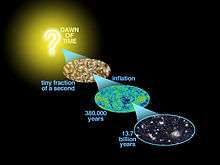Definify.com
Definition 2026
ylem
ylem
English

A diagram positing the history of the cosmos produced by the National Aeronautics and Space Administration (NASA) and the Wilkinson Microwave Anisotropy Probe (WMAP) Science Team. Scientists believe that shortly after the Big Bang (marked “dawn of time”), the universe was made up of the ylem, a hot and dense plasma (first oval shape). Recombination of the plasma into neutral atoms and the consequent release of photons 380,000 years after the Big Bang led to radiation forming the cosmic microwave background, which has been recorded by the satellite called the WMAP (second oval shape). The last oval shape shows the universe as it exists today.

An image of the universe shortly after the Big Bang, based on nine years' worth of cosmic microwave background data gathered by WMAP. The colour differences in the image represent temperature fluctuations corresponding to the ‘seeds’ that grew into galaxies.
Noun
ylem (uncountable)
- (astronomy, cosmology, physics, now chiefly historical) In the Big Bang theory, the hot and dense plasma which made up the cosmos at the time of recombination in an early stage of its expansion and cooling, when the first atoms formed and photons decoupled. The ylem is regarded as the source of the cosmic microwave background. [from 1948.]
- 1948 December 1, R[alph] A[sher] Alpher, “A Neutron-capture Theory of the Formation and Relative Abundance of the Elements”, in Physical Review, volume 74, number 11, College Park, Md.: American Physical Society, DOI:, OCLC 896770069, page 1581, column 1:
- Very shortly after the beginning of the universal expansion, the ylem was a gas of neutrons only. [Footnote: According to Webster's New International Dictionary, 2nd Ed., the word ‘ylem’ is an obsolete noun meaning ‘The primordial substance from which the elements were formed.’ It seems highly desirable that a word of so appropriate a meaning be resurrected.]
- 1952, George Gamow, The Creation of the Universe, New York, N.Y.: Viking Press, OCLC 999160; republished as New York, N.Y.: Viking Press, 1961, 2nd edition, OCLC 642243549, page 53:
- Let us now consider the state of matter during the first minutes of the expansion process, when the temperature of the universe was many billions of degrees high. […] [T]he state of matter must be visualized as a hot gas formed entirely by nuclear particles; that is, protons, neutrons, and electrons. […] We will call this primordial mixture of nuclear particles "Ylem," [footnote: Pronounced: ī′lěm] reviving an obsolete noun which, according to Webster's Dictionary, means "the first substance from which the elements were supposed to be formed." Next we can ask what happened to the Ylem when its density and temperature began to drop as the result of the rapid expansion taking place in the young universe.
- 1959, James Blish, chapter 7, in A Clash of Cymbals [US title: The Triumph of Time] (Cities in Flight; 4), London: Faber and Faber, ISBN 978-0-571-06224-9, page 171:
- The ylem was the primordial flux of neutrons out of which all else emerged.
- 2008, Piers Bizony, “Part Eight, Ylem”, in Atom, Thriplow, Cambridgeshire: Icon, ISBN 978-1-84046-873-1, page 171:
- He [George Gamow] surmised that that the universe began as a super-condensed raging inferno of protons, neutrons and electrons, which he and his colleagues called the ylem […] The internal pressures of the ylem caused it to expand outward extremely rapidly. After a few minutes the ylem cooled down sufficiently to allow the strong force to bind neutrons and protons together into deuterium nuclei. […] Then there was just enough time for some of the deuterium to fuse into helium before temperatures and pressures of the ylem became too diffuse to allow more fusions.
-
References
- ↑ R[alph] A[sher] Alpher; H[ans] Bethe; G[eorge] Gamow (1 April 1948), “The Origin of Chemical Elements”, in Physical Review, volume 73, issue 7, College Park, Md.: American Physical Society, DOI:, OCLC 896770069, page 803.
- ↑ Ralph A[sher] Alpher; Robert Herman (2001) Genesis of the Big Bang, New York, N.Y.: Oxford University Press, ISBN 978-0-19-511182-8, page 2.
- ↑ George Gamow; Charles Weiner, interviewer (25 April 1968), “Oral Histories: George Gamow”, in Neils Bohr Library & Archives, American Institute of Physics, archived from the original on 2 June 2016: “Gamow: You can look in the Webster dictionary. This is a word—I think it’s an old Hebrew word, but Aristotle was using it—in Webster dictionary it says “material from which elements were formed.” / Weiner: The primordial substance? / Gamow: The primordial substance, yes—ylem. […] I mean this is the old Hebrew word meaning something like “space between heaven and earth.””.
- ↑ R[alph] A[sher] Alpher; R[obert] C. Herman (15 December 1948), “On the Relative Abundance of the Elements”, in Physical Review, volume 74, issue 12, College Park, Md.: American Physical Society, DOI:, OCLC 896770069, pages 1737–1742.